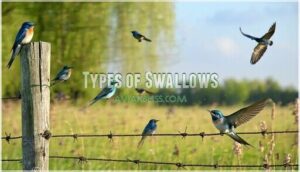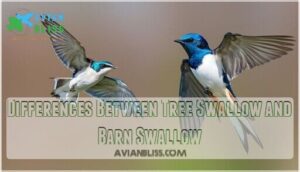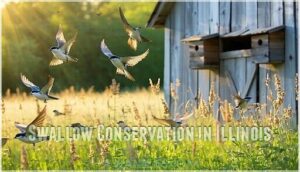This site is supported by our readers. We may earn a commission, at no cost to you, if you purchase through links.

The common barn swallow, with its rust-colored belly and deeply forked tail, leads the pack alongside tree swallows sporting their iridescent blue-green backs.
Northern rough-winged swallows prefer sandy riverbanks, while bank swallows dig tunnel nests in clay bluffs.
Cliff swallows build mud fortresses under bridges, and purple martins grace backyard houses.
The violet-green swallow remains extremely rare but possible, and these insect-eating champions arrive in spring, transforming Illinois skies into a choreographed dance of wings.
Timing your observations correctly can reveal fascinating behaviors most people never witness, making it a unique experience to observe these birds in their natural habitat, showcasing their aerial acrobats skills.
Table Of Contents
- Key Takeaways
- Swallows in Illinois
- Types of Swallows
- Swallow Identification
- Swallow Conservation in Illinois
- Attracting Swallows to Your Yard
- Frequently Asked Questions (FAQs)
- Do swallows live in Illinois?
- Are swallows good birds to have around?
- What is the difference between a tree swallow and a bank swallow?
- How to tell the difference between swifts and swallows?
- Where can I see Swallows in the summer?
- What is a tree swallow?
- Where do swallows live?
- What are the different types of swallows?
- What do barn swallows look like?
- How do tree swallows breed?
- Conclusion
Key Takeaways
- You’ll find seven distinct swallow species in Illinois, including the common barn swallow with its rust-colored belly and deeply forked tail, tree swallows with iridescent blue-green backs, and the rare violet-green swallow that occasionally appears during migration.
- You can easily identify different species by examining their size, coloration, and flight patterns – barn swallows showcase lightning-fast dive patterns, while tree swallows display smooth soaring ability with graceful circular glides.
- You’ll spot these aerial insect hunters from mid-April through early September, with peak migration occurring in late April and early May when they’re most active during warm, calm mornings after rain.
- You can transform your yard into a swallow haven by installing species-specific nest boxes 5-10 feet high near water sources, maintaining pesticide-free gardens to preserve insect populations, and providing shallow water features with muddy areas for nesting materials.
Swallows in Illinois
Illinois hosts seven distinct swallow species that transform the state’s skies each spring, from the common Barn Swallow with its rust-colored belly to the rare Cave Swallow that occasionally appears during migration.
Illinois transforms into an aerial highway each spring as seven remarkable swallow species reclaim their Prairie State territories.
You’ll find these aerial acrobats hunting insects across diverse habitats including open fields, water bodies, and urban areas from April through September, with each species displaying unique flight patterns and nesting behaviors.
The presence of these swallows can be observed in various locations, highlighting the importance of understanding their habits and habitats to appreciate these aerial acrobats fully.
Species Found in Illinois
Across Illinois, you’ll discover seven remarkable swallow species that transform the state’s skies into aerial highways.
The barn swallow dominates with its rusty-orange belly and deeply forked tail, while tree swallows flash iridescent blue-green backs near water.
Purple Martins, the largest species, nest in colonies, and Northern Rough-winged Swallows hunt quietly over rivers.
The rare cliff swallow appears occasionally with its distinctive white forehead patch.
Bank Swallows burrow into sandy banks, and Cave Swallows rarely visit during fall migration.
Each species showcases unique nesting behaviors and migration timing, making swallow identification an exciting challenge for Illinois birders.
Similar to Wisconsin, insect control is essential for ecological balance.
Distribution and Habitat in Illinois
Illinois swallows showcase remarkable habitat preferences across the state’s diverse landscapes.
These aerial acrobats thrive in regional abundance throughout agricultural fields, wetlands, and urban environments.
Conservation areas provide critical nesting locations where Illinois birds establish colonies.
They’re skilled at aerial insect hunting, feeding primarily on flying insects.
Bird habitats in Illinois support swallow habitat needs through:
- Open meadows and farmlands for Barn Swallows
- Water-adjacent areas preferred by Tree Swallows
- Bridge structures and culverts for Cliff Swallows
Each bird species in Illinois adapts uniquely to local conditions, creating dynamic populations that flourish in both rural countryside and metropolitan settings.
Migration Patterns in Illinois
Migration transforms Illinois into a bustling highway for swallows each year. These aerial acrobats follow predictable patterns that’ll help you spot them during peak seasons.
Arrival Timing begins in early April when Barn Swallows return from their Central American wintering grounds. Northern Rough-winged Swallows follow shortly after, while Purple Martins arrive by late April. Climate Impact affects these schedules – warmer springs accelerate arrivals, while cold snaps delay them.
One notable species boasts blue-black feathers on their backs.
Key migration insights for Illinois swallows:
- Stopover Locations include prairie wetlands and agricultural areas rich in insects
- Route Variations follow the Mississippi Flyway’s natural corridors
- Departure Triggers occur when insect populations decline in late July
- Fall swallow migration in Illinois peaks during August’s first two weeks
- Weather fronts create concentrated migration events you can easily observe
Swallow migration in Illinois reveals nature’s remarkable timing. These birds navigate thousands of miles with precision that puts GPS systems to shame.
Best Time to Spot Swallows in Illinois
You’ll catch swallows in Illinois at their best from mid-April through early September, with peak migration occurring in late April and early May.
Breeding season brings the most activity from June through July when pairs establish territories.
Weather influence matters – warm, calm mornings after rain create perfect swallow sightings conditions as insects emerge.
Habitat preference draws them to open areas near water, making lakeshores and prairie edges prime birdwatching Illinois spots.
Daily activity peaks during early morning and late afternoon when Illinois birds hunt most actively.
Plan your swallow migration viewing around these ideal times for guaranteed success.
Types of Swallows
You’ll encounter seven distinct swallow species across Illinois, each with unique physical characteristics and behavioral patterns that make identification straightforward once you know what to look for.
These aerial insectivores range from the common Barn Swallow with its deeply forked tail and rusty-orange underparts to the rare Cave Swallow that occasionally appears during fall migration.
Barn Swallow Description
You’ll spot Illinois’s most common swallow by its striking rusty-orange belly and deeply forked tail. Barn Swallows showcase iridescent blue-black backs that shimmer in sunlight, making swallow identification straightforward for beginners.
Their graceful flight style involves swooping close to ground level while hunting insects.
- Plumage Details: Vibrant orange underparts with navy blue upperparts
- Tail Morphology: Deeply forked with distinctive white spots
- Size Comparison: 6-7 inches from bill to tail tip
Tree Swallow Description
You’ll spot Tree Swallows near Illinois waterways, where their iridescent plumage creates stunning displays.
These compact birds showcase deep blue-green backs contrasting with pure white underparts—perfect for swallow identification.
| Feature | Description |
|---|---|
| Size | 4.7-5.9 inches long |
| Iridescent Plumage | Blue-green backs, white bellies |
| Nesting Habits | Woodpecker holes, nest boxes |
| Habitat Preference | Lakes, marshes, wetlands |
Their diet details include flying insects caught mid-flight.
Conservation status remains stable thanks to their adaptable nesting habits.
Watch these acrobatic swallows perform aerial maneuvers over your favorite Illinois birding spots.
Northern Rough-winged Swallow Description
You’ll recognize the Northern Roughwinged Swallow by its understated elegance—a bird that proves subtlety can be stunning.
This Illinois swallow species showcases unique plumage variations with uniformly light brown upperparts and buff-white underparts, making swallow identification straightforward once you know what to look for.
Their distinctive wing feather edges give them their name and exceptional flight characteristics:
- Serrated wing edges that create silent, efficient flight patterns
- Habitat preferences for water sources where they hunt insects with precision
- Nesting behavior in burrows and cavities near riverbanks throughout Illinois
Perfect for bird identification enthusiasts seeking something special, with a unique combination of silent, efficient flight and precision hunting abilities.
Other Swallow Species in Illinois
Beyond the common swallow species in Illinois, you’ll encounter several fascinating aerial acrobats that make this state their seasonal home.
These additional swallow species in Illinois bring unique characteristics and behaviors that’ll challenge your ID Challenges skills.
Cliff Swallow populations build remarkable mud nests under bridges, while Bank Swallow colonies excavate tunnels in sandy riverbanks. The rare Cave Swallow occasionally appears during fall migration, and Purple Martin numbers face concerning Martin Decline across the region.
The Northern Rough-winged Swallow, another possible sighting, boasts serrated wing edges adapted for agile flight.
Each species offers distinct identification features:
- Cliff Swallows sport rust-red foreheads and squared tails
- Bank Swallows display brown chest bands and earth-toned plumage
- Cave Swallows show orange faces with blue-black backs
- Purple Martins represent Illinois’s largest swallow species
Swallow Identification
You can distinguish Illinois swallows by examining their size, coloration, and distinctive flight patterns.
Look for key features like the Barn Swallow’s deeply forked tail and rusty-orange underparts, the Purple Martin’s large size and dark iridescent plumage, or the Tree Swallow’s brilliant blue-green back with crisp white underparts, which are key features.
Differences Between Barn Swallow and Purple Martin
You’ll easily distinguish these two swallow species through key identification features.
Size differences are obvious – Purple Martins measure 7-8 inches while Barn Swallows appear more slender.
Plumage comparison reveals Purple Martins’ deep blue-black coloration versus Barn Swallows’ rusty-orange bellies.
Nesting habits differ too: Purple Martins prefer colony houses, while Barn Swallows build mud nests under eaves.
Differences Between Tree Swallow and Barn Swallow
Mastery of swallow identification starts with understanding these two common Illinois residents. Tree Swallows display brilliant iridescent blue-green backs with pristine white underparts, while Barn Swallows showcase navy blue upperparts and distinctive rusty-orange bellies.
Their tail shape provides another key identifier—Tree Swallows have slightly notched tails versus Barn Swallows’ deeply forked, streamlined design.
Key differences for accurate swallow species identification:
- Plumage comparison: Tree Swallows feature white bellies; Barn Swallows sport orange undersides
- Tail shape: Shallow notch versus dramatic fork
- Nesting habits: Tree Swallows prefer nest boxes; Barn Swallows build mud cups
- Habitat preference: Tree Swallows favor water proximity; Barn Swallows adapt to human structures
Swallow Identification by Size and Color
Size comparison becomes your first clue when identifying Illinois swallows. Purple Martins dominate at 8 inches while Bank Swallows barely reach 5 inches – that’s like comparing a robin to a sparrow.
Bird coloration reveals each species’ signature look through distinct plumage variations. Understanding bird size categories aids quick identification.
Here’s what you’ll spot in the field:
- Barn Swallows flash steel-blue backs with rusty-orange throats and deeply forked tails
- Tree Swallows showcase metallic blue-green upperparts contrasting with pure white underparts
- Purple Martins display dark purplish-blue plumage with an iridescent sheen across their large frames
- Bank Swallows wear modest brown backs with distinctive dark chest bands
These bird identification features make swallow species recognition surprisingly straightforward once you know what to look for.
Swallow Identification by Flight Pattern
Beyond size and color, watching flight patterns gives you the clearest window into swallow identification.
Each Illinois swallow species showcases unique wing shapes and flight speeds that’ll help you distinguish them instantly.
- Barn Swallows: Lightning-fast dive patterns with sharp directional changes
- Tree Swallows: Smooth soaring ability with graceful, circular glides
- Northern Rough-winged Swallows: Steady, low-altitude cruising near water
- Purple Martins: Powerful wingbeats with commanding group flight formations
These bird identification features make spotting different swallow species straightforward once you know what to watch for overhead.
Swallow Conservation in Illinois
You can play a vital role in protecting Illinois’s swallow populations, which face increasing threats from habitat loss and declining insect availability.
Understanding conservation efforts helps you make informed decisions about supporting these aerial insect hunters through proper nesting site management and habitat preservation.
Are Barn Swallows Protected in Illinois
After learning to identify swallows by their unique characteristics, you’ll want to understand their Legal Protections in Illinois.
Barn Swallow populations receive thorough federal protection under the Migratory Bird Treaty Act. This means you can’t legally disturb, harm, or remove active nests containing eggs or young birds.
Nesting Regulations are strict – only inactive nests can be removed. These Conservation Efforts help maintain stable Population Trends across Illinois.
Bird conservation laws protect all swallows from illegal capture, transport, or sale. Understanding these protections helps you appreciate why respecting swallow nesting sites supports their continued presence in Illinois.
Threats to Swallow Populations in Illinois
While barn swallows enjoy legal protection, they’re still battling serious threats across Illinois.
You’ll notice these challenges hitting swallow populations hard:
- Habitat Loss from urban sprawl eliminates essential nesting areas
- Insecticide Use wipes out the flying insects swallows need to survive
- Climate Change disrupts migration timing and breeding cycles
- Nesting Competition from invasive species crowds out native birds
- Invasive Species alter ecosystems and reduce available resources
Bird decline affects all species, but swallows face unique pressures as aerial hunters.
Bird conservation efforts in Illinois now prioritize protecting these insect-eating champions, since bird population trends show concerning drops in several species.
Swallow Nesting Sites in Illinois
Across Illinois, swallow nesting sites reveal fascinating patterns that’ll transform how you view these aerial masters.
Each species displays distinct preferences for their homes, creating diverse nesting communities throughout the state.
Understanding where swallows nest helps you appreciate their remarkable adaptability:
- Barn Swallows construct mud nests on Human Structures like barns, bridges, and building eaves using specific Nest Materials including mud pellets and grass
- Tree Swallows occupy Natural Cavities in dead trees or nest boxes near water sources for ideal foraging
- Cliff Swallows form massive colonies with Colony Size reaching hundreds of pairs on vertical surfaces
- Bank Swallows excavate tunnels in steep dirt banks, creating dense nesting communities
- Northern Rough-winged Swallows prefer isolated pair nesting in sandy banks or artificial structures
These diverse swallow nesting sites across Illinois demonstrate how each species has evolved unique strategies for Nesting Success in the Prairie State’s varied landscapes.
How to Support Swallow Conservation in Illinois
Beyond providing nesting sites, you can champion swallow conservation across Illinois through meaningful action.
Your efforts directly impact bird conservation programs and bird habitat preservation statewide.
Here’s how you’ll make a difference:
- Support pesticide reduction initiatives protecting insect populations that fuel swallow diets
- Participate in citizen science projects documenting migration patterns and breeding success
- Advocate for habitat preservation policies safeguarding wetlands and open spaces
- Launch awareness campaigns educating neighbors about bird conservation efforts
Every action strengthens nesting structures and guarantees future generations witness these aerial masters.
Attracting Swallows to Your Yard
You can transform your yard into a swallow haven by providing the right nesting structures, water sources, and insect-rich environments that these aerial hunters need.
Creating open spaces near water features and installing species-specific nest boxes will encourage different swallow species to establish breeding territories on your property, which can be a haven.
Creating a Swallow-Friendly Habitat
Throughout Illinois backyards, creating a swallow-friendly habitat starts with establishing native plants like purple coneflower and wild bergamot that naturally attract diverse insects.
These insect-eating birds thrive when you avoid natural insecticides, allowing beneficial bugs to flourish as their primary food source.
You can find resources for sourcing these plant species online.
Install shallow water sources such as birdbaths or small fountains—swallows in Illinois love skimming surfaces while hunting.
Provide nesting materials like mud puddles, dried grass, and small twigs in accessible areas.
Strategic placement of predator deterrents like reflective tape keeps cats and larger birds away from bird nesting sites.
Open lawn spaces create perfect aerial hunting grounds for these acrobatic fliers.
By focusing on habitat preservation through pesticide-free gardening and diverse plantings, you’ll transform your yard into a welcoming oasis that supports local swallow populations throughout their breeding season.
Building a Swallow Nest Box
With swallows returning to Illinois each spring, building the perfect swallow nest box becomes your gateway to hosting these aerial acrobats. Material selection starts with exterior-grade plywood or rough-cut boards—durability matters when you’re creating a seasonal home.
Box dimensions require precision: maintain a 5" x 5" floor space with an entrance hole measuring 1-3/8" to 1-1/2" in diameter. Position this opening 7" above the floor panel for ideal access.
Smart mounting techniques involve:
- Installing boxes 5-10 feet high on poles or sturdy structures
- Choosing locations near water sources and open flight paths
- Spacing multiple boxes 20-30 feet apart
- Ensuring clear approaches without vegetation obstacles
Predator guards protect your feathered tenants—smooth mounting surfaces and metal baffles prevent unwanted visitors. Don’t forget drainage holes in the bottom panel. To find the best options, consider buying a pre-made box.
Maintenance tips include annual cleaning after breeding season, removing old materials, and inspecting for damage. Your swallow nesting project creates lasting bird nesting success throughout Illinois.
Food Sources for Swallows
Creating the perfect aerial insectivore buffet starts with understanding swallow diet fundamentals.
Your feathered acrobats prefer flying insects—dragonflies, mosquitoes, flies, and gnats captured mid-flight through precise foraging strategies.
Maintain pesticide-free zones since pesticide impact devastates their insect prey supply.
Plant native wildflowers to boost insect abundance naturally. To further support local ecosystems, consider purchasing native wildflower seeds.
These bird foraging behavior experts show impressive prey selection, targeting protein-rich catches.
Tree Swallows add diet variation with bayberries during migration, proving these swallow foraging habits adapt seasonally for ideal nutrition.
How to Encourage Swallows to Stay in Your Yard
Three key strategies will turn your Illinois yard into a swallow magnet that keeps these aerial acrobats coming back season after season.
Swallows thrive when you provide the essentials they can’t find elsewhere. Your yard becomes their headquarters when you offer consistent water features, abundant insect attractants, and safe roosting spots. These bird attractions create an irresistible environment for swallow nesting and extended stays. A great way to do this is to plant native trees to provide natural food and shelter.
Here’s your action plan for successful bird watching:
- Install predator deterrents like baffles on poles and maintain open flight paths around nest boxes
- Position shallow water sources near muddy areas, giving swallows easy access to drinking water and nesting materials
- Plant native flowers and avoid pesticides to naturally boost flying insect populations
Smart placement matters most. Mount boxes 8-10 feet high in quiet zones, away from heavy foot traffic but visible for your bird watching enjoyment.
Frequently Asked Questions (FAQs)
Do swallows live in Illinois?
Yes, you’ll find six swallow species calling Illinois home during summer months.
These aerial acrobats migrate here from April through September, including Barn Swallows, Purple Martins, and Tree Swallows hunting insects across the state.
Are swallows good birds to have around?
You’ll love having these aerial acrobats around your yard.
They’re natural pest controllers, devouring thousands of mosquitoes, flies, and other flying insects daily.
They provide endless entertainment with their graceful swooping flights.
What is the difference between a tree swallow and a bank swallow?
You’ll spot tree swallows by their iridescent blue-green backs and pure white bellies, while bank swallows show light brown coloring with a distinct dark chest band across their white underparts.
How to tell the difference between swifts and swallows?
Looking skyward, can you spot the difference?
Swifts have longer, curved wings and never perch on wires like swallows do.
Swallows have shorter, triangular wings and you’ll see them resting frequently on branches and power lines.
Where can I see Swallows in the summer?
You’ll find swallows near water sources like lakes, rivers, and ponds where they hunt insects. Check open fields, farms, barns, bridges, and marshes during summer months from April through September.
What is a tree swallow?
Tree Swallows are medium-sized birds with iridescent blue-green backs and bright white underparts.
You’ll recognize them by their sleek appearance and graceful flight patterns as they hunt insects over water bodies throughout Illinois summers.
Where do swallows live?
Swallows inhabit diverse environments across Illinois, from open fields and farmlands to wetlands and urban areas.
You’ll find them nesting under bridges, in barns, tree cavities, and burrows near water sources.
What are the different types of swallows?
Like nature’s aerial ballet dancers, you’ll find six distinct swallow types: Barn, Northern Rough-winged, Purple Martin, Tree, Cliff, and Bank swallows.
Each species brings unique characteristics, from the Barn’s forked tail to Purple Martin’s impressive size.
What do barn swallows look like?
You’ll recognize barn swallows by their distinctive navy blue backs, rusty-orange bellies, and deeply forked tails.
They’re graceful fliers with long, pointed wings and small bills, swooping low over open areas.
How do tree swallows breed?
You’ll notice these birds arrive in spring seeking nest boxes near water.
They’re cavity nesters who’ll use birdhouses you provide, laying 4-6 white eggs that hatch after two weeks of incubation, which is a complete concept in their nesting behavior.
Conclusion
While many birds struggle with habitat loss, swallows in Illinois continue to thrive through their remarkable adaptability.
You’ve discovered seven distinct species that transform Prairie State skies each spring, from common barn swallows to elusive violet-green varieties.
Your backyard can become a swallow sanctuary with proper nest boxes and insect-friendly gardens.
These aerial masters remind us that conservation success happens when we recognize species needs.
Start watching this spring—you’ll witness nature’s most graceful aviators performing their ancient migration dance overhead.
- https://dnr.illinois.gov/education/wildaboutpages/wildaboutbirds/wildaboutbirdscrows/wabcliffswallow.html
- https://www.youtube.com/c/BadgerlandBirding
- https://globalbirdinginitiative.org/bird-identification/species-by-location/illinois-us/swallows-in-illinois/
- https://wildexplained.com/animal-encyclopedia/the-fascinating-migration-of-the-barn-swallow/
- https://www.mdpi.com/2673-6004/6/2/17













